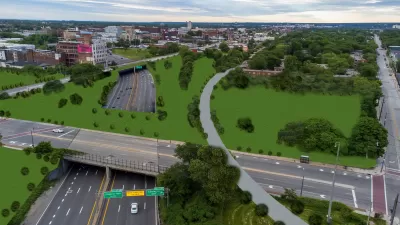A new map reveals the scale of the food desert challenge in Cleveland and environs.
Ginger Christ reports that as many as 450,000 people in Cuyahoga County, Ohio live in a food desert, lacking convenient access to healthy food and suffering from higher risks of chronic disease.
The recently released Cuyahoga County Supermarket Assessment mapped the county's food deserts to illustrate the scale of the problem, including neighborhoods in the city of Cleveland and its suburbs, and overlays the food desert map with demographic data. According to Christ, the project identifies "about 20 spots in the county, in areas such as Glenville and Bedford Heights, where access to healthy food is the most difficult."
While the article is able to report the recent opening of a supermarket in Euclid, details about the efforts of the Cuyahoga County Board of Health's Creating Healthy Communities program are lacking in the article. The county's program is made possible by funding from the Ohio Department of Health, and more information is available online and in the video found below.
FULL STORY: As many as 450,000 people in the county live in food deserts; group wants to increase access to supermarkets

Alabama: Trump Terminates Settlements for Black Communities Harmed By Raw Sewage
Trump deemed the landmark civil rights agreement “illegal DEI and environmental justice policy.”

Study: Maui’s Plan to Convert Vacation Rentals to Long-Term Housing Could Cause Nearly $1 Billion Economic Loss
The plan would reduce visitor accommodation by 25% resulting in 1,900 jobs lost.

Why Should We Subsidize Public Transportation?
Many public transit agencies face financial stress due to rising costs, declining fare revenue, and declining subsidies. Transit advocates must provide a strong business case for increasing public transit funding.

Paris Bike Boom Leads to Steep Drop in Air Pollution
The French city’s air quality has improved dramatically in the past 20 years, coinciding with a growth in cycling.

Why Housing Costs More to Build in California Than in Texas
Hard costs like labor and materials combined with ‘soft’ costs such as permitting make building in the San Francisco Bay Area almost three times as costly as in Texas cities.

San Diego County Sees a Rise in Urban Coyotes
San Diego County experiences a rise in urban coyotes, as sightings become prevalent throughout its urban neighbourhoods and surrounding areas.
Urban Design for Planners 1: Software Tools
This six-course series explores essential urban design concepts using open source software and equips planners with the tools they need to participate fully in the urban design process.
Planning for Universal Design
Learn the tools for implementing Universal Design in planning regulations.
Smith Gee Studio
Alamo Area Metropolitan Planning Organization
City of Santa Clarita
Institute for Housing and Urban Development Studies (IHS)
City of Grandview
Harvard GSD Executive Education
Toledo-Lucas County Plan Commissions
Salt Lake City
NYU Wagner Graduate School of Public Service





























